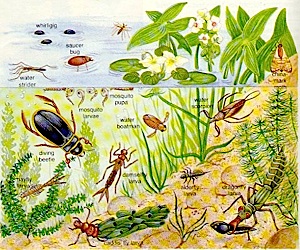Neonicotinoids are a new group of insecticides, and little is known about their toxicity to nontarget freshwater organisms an potential effects on freshwater ecosystems. The aim of this study is to establish the acute toxicity and histopathological effects of thiamethoxam-based pesticide on the gill tissue of Gammarus kischineffensis. In this study G. kischineffensis samples were exposed to 2.5, 5, 7.5, 10, 15, 20, 25, 30, 35, 40, 45, 50, 60, 70, 80, 90 and 100 mg/l of commercial grade thiamethoxam for 96 h. The 24, 48, 72 and 96 h LC50 values were determined as 75.619, 23.505, 8.048 and 3.751 mg/l respectively. In histopathological study the individuals were exposed to 0.004, 0.04 and 0.4 mg/l thiamethoxam concentrations for 14 days. The results showed that the most common changes at all doses of thiamethoxam were vacuolization and hemostatic infiltration in the gill tissue of G. kischineffensis.
Source:
Pelin Uğurlu, Erhan Ünlü, Elif İpek Satar. Environmental Toxicology and Pharmacology
Volume 39, Issue 2, March 2015, Pages 720–726
http://www.sciencedirect.com/science/article/pii/S1382668915000307

- Log in to post comments

Time-cumulative toxicity of thiamethoxam to G. kischineffensis
There is a very important shift in our understanding of the risk of neonicotinoid insecticides. Their risk may increase exponentially over time, rendering even very small amounts of neonicotinoids much more toxic than previously realized. Dutch researcher Dr. Henk Tennekes, with Dr. Francisco Sanchez-Bayo of Australia, have recently published a review article in the Journal of Environmental & Analytical Toxicology: "Time-Dependent Toxicity of Neonicotinoids and Other Toxicants: Implications for a New Approach to Risk Assessment" (attached). Their starting point is the Druckrey–Küpfmüller equation dt^n = constant (where d = daily dose and t = exposure time-to-effect, with n>1). The Druckrey–Küpfmüller equation established in the early 1960s for genotoxic carcinogens explains why toxicity may occur after prolonged exposure to very low toxicant levels. In essence, this equation states that the total dose required to produce the same effect decreases with decreasing exposure levels, even though the exposure times required to produce the same effect increase with decreasing exposure levels. Druckrey and Küpfmüller inferred in the late 1940s that if both receptor binding and the effect are irreversible, exposure time would reinforce the effect. Recently, similar dose–response characteristics have been established for the toxicity of the neonicotinoid insecticides imidacloprid and thiacloprid to arthropods. The paper reported above confirms that thiamethoxam has similar dose–response characteristics. The entire dataset fits the equation Ln(T50) = 2.191 - 0.499Ln(LC50), with r2 =0.98 and a value of n = 2.0. Using only the four LC50 values, the equation is Ln(T50) = 2.04 - 0.46Ln(LC50), with r2=0.99 and a value of n = 2.2. Either case, it’s perfect match of Druckrey-Küpfmüller’s equation.